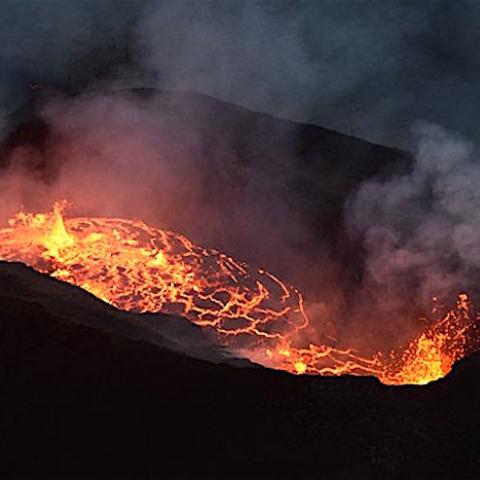Editor's note: Volcano Watch is a weekly article and activity update written by U.S. Geological Survey Hawaiian Volcano Observatory scientists and affiliates. This week’s article was written by Hawaiian Volcano Observatory geologist Drew Downs.
Kīlauea at Hawai'i Volcanoes National Park is one of the most active volcanoes on Earth, with a majority of its eruptions occurring at its summit or one of its two rift zones, the East Rift Zone and Southwest Rift Zone. The Southwest Rift Zone hasn't erupted since New Year’s Eve 1974; almost exactly 49 years ago.
Now is an apt time to revisit the 1974 Southwest Rift Zone eruption in the wake of the recent elevated seismicity in similar areas. Elevated earthquake activity, sometimes over a hundred earthquakes a day, has been occurring since early October in the south caldera and Southwest Rift Zone regions of Kīlauea.
Kīlauea erupted three times in 1974; twice at the summit—in July and September—and once from the Southwest Rift Zone in December. Immediately following the September 1974 summit eruption, the summit region of Kīlauea started undergoing very high rates of inflation (approximately 30 microradians of ground tilt from September to December).
Seismicity increased in the summit and upper East Rift Zone regions for the month leading up to the December eruption. By the evening of December 30, the summit and upper Southwest Rift Zone were experiencing earthquakes at a rate of 2–4 per minute. Just after midnight, at 12:10 a.m. HST on December 31, the USGS Hawaiian Volcano Observatory (HVO) seismic alarm sounded, tiltmeters recorded sharp deflation, and increased tremor indicated that magma was on the move out of the summit region.
HVO staff did not have long to wait, with the first lava fountains observed on New Year’s Eve at 2:56 a.m. HST in the Kaʻū Desert region of Hawaiʻi Volcanoes National Park. These lava fountains reached average heights of 115–130 feet (35–40 meters), but on rare occasions threw lava bombs up to 330 feet (100 meters) high. Over ten fissures eventually opened during the first hour of the eruption, to the east-northeast and west-southwest, forming a near-continuous fountain of lava that stretched over 2.5 miles (4.2 kilometers) long.
Lava fountain heights started to rapidly decline throughout the morning and the eruption was over by 8:50 a.m. HST. Despite the short duration of this eruption—only about six hours—lava managed to flow approximately 7.5 miles (12 kilometers) from source fountains, emplacing an uncommonly thin (typically less than 1 meter or 3 feet thick) lava flow across a large area of the upper Southwest Rift Zone.
HVO continues to monitor the ongoing unrest in the summit and Southwest Rift Zone regions of Kīlauea, with increased rates of earthquakes and ground deformation indicating that magma is moving in this area. You can learn about this activity in the Kīlauea updates that are posted daily at https://www.usgs.gov/volcanoes/kilauea/volcano-updates.
Whether this increase in activity over the past several months is a prelude to a new eruption in the Southwest Rift Zone in the near future, or if another summit eruption will occur is not possible to forecast currently. However, the Southwest Rift Zone remains an active part of Kīlauea that will experience lava flows in the future.





 Support Essential Coverage of Essential Places
Support Essential Coverage of Essential Places







Add comment